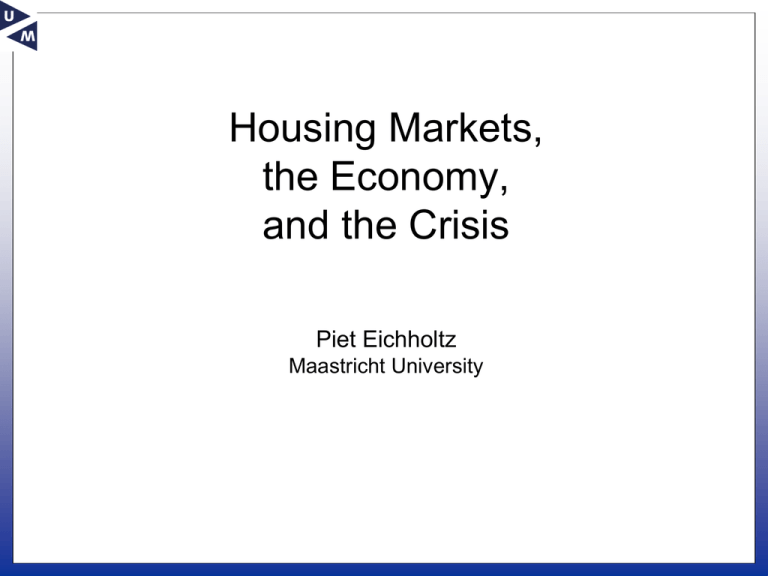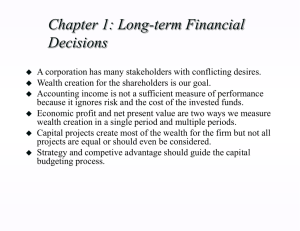Demographic Change and the Demand for Housing in England
advertisement

Housing Markets, the Economy, and the Crisis Piet Eichholtz Maastricht University Housing market crises and economic crises • IMF recently investigated 122 recessions in 21 OECD countries 1960 and 2007 • 28 recessions coincided with a severe housing market crisis – Recessions with housing market crisis are deeper and longer • Cumulative output loss 3.7% vs 2.3% for normal recession • Last one quarter longer – Housing investments shrunk 8 to 12 quarters • Effects far deeper than for equity market crises – GDP loss housing market crisis: 3,4% (pre) to 0,8% (post) – GDP loss equity market crisis: 4,0% (pre) to 2,6% (post) • How is that possible? Mechanism is saving and consumption • House prices effects on consumption growth larger than equity price effects – House price rises seem(ed) more permanent – Banks are more willing to finance more and/or home owners willing to save less • 2001 - 2005 US housing wealth growth explains part of consumption growth – Effect is especially strong for young households. Older people are more careful • Development housing market explains quarter of Dutch economic growth 1995 - 2000 (DNB, 2003) How does home ownership affect household behavior? Consumption effect housing much bigger than financial wealth • Lettau and Ludvigson (2004) – Unexpected wealth shocks must be perceived as permanent to affect consumption spending • Case, Quigley, and Shiller (2005) – Look at macro data across US states and across OECD countries – Changes in housing wealth affect consumption more than changes in financial (i.e. stock market related) wealth • Bostic, Gabriel, and Painter (2005) – US housing wealth growth (2001-2005) explains 12% consumption growth – Effect especially big for non-durable consumption – Effect strongest for young people. Older people more careful • Engelhardt (1995) and Skinner (1996) – Effect of US house wealth changes on saving is asymmetric – Gains in wealth decrease savings by 0.4 cent per dollar Housing markets kept the world economy afloat between 2001 and 2003 • Crisis equity markets 2000-2003 comparable to ’29 … – US: loss in equity wealth 2000-2001 = $ 8 trillion – NL: loss in equity value 2000-2003 = 65% or € 574 billion • … but that recession was relatively mild • Housing markets delivered wealth compensation – US: gain in housing wealth 2001-2004 = $ 9.6 trillion – NL: gain in housing wealth 2000-2005 = 21%, or € 228 billion But this came at a cost Credit growth and house price changes, EU cross section And this is the result Outstanding mortgages in percentage of GDP Selected countries, 1983 and 2007 What happens when house prices go down? • Consumption effect is unfortunately larger for price falls than for price growth • Saving goes up substantially • Engelhardt (1996): asymmetric effect of house prices on US consumption in 1980s – Only price falls matter • Skinner (1996): every dollar of house price fall leads to 10 cents in extra savings in the US • Dutch Central Planning Bureau (2006) found effect of price falls to be 2.5 to 5 times as strong as price rises Will European house prices fall across the board? • Structural price falls sofar mostly in countries and regions with large over supply and/or massive fall in demand – (US), Spain, Ireland, UK • “Every housing downturn begins with an excess supply of available dwellings” (Case and Quigley, 2008) A scenario for years to come? Netherlands early ’80s: real price fall 48% 400,00 Nominale index Reële index 300,00 200,00 100,00 0,00 1965 1967 1969 1971 1973 1975 1977 1979 1981 1983 1985 1987 1989 House price developments in Europe (1) Mostly booms until 2007 … House price developments in Europe (2) … but not all booms turn into busts … … and one market does not boom at all House prices relative to income give better perspective on booms … … and Germany is still the great outlier A housing market with history: Amsterdam Volatile with booms and busts, but stationary in real terms 350 300 250 200 150 100 50 0 1650 1700 1750 rents (1650=100) 1800 1850 1900 1950 house prices (1650=100) 2000 And how about the U.S. housing market? Just had the biggest boom/bust in history Components of crisis differ strongly by country • Market sentiment still bad in many countries – Large hardware spending postponed, consumption still reasonable in many countries • Demografics is getting problematic in many regions in east and south – Central Europe, Club Med – Without large scale intervention, these markets are doomed • Economies may get back into recession – Unemployment varies strongly across countries • Interest rates (euribor, IRS) still very low – Liquidity premiums are falling • Oversupply problematic in some countries – But not in most of Netherlands Expected demographics: change in total population Large differences across Europe until 2050 Change total pop. 2010-2050 Demographics, Netherlands 1995-2050 800.000 households to go Aantal huishoudens (+ prognose) 8500 8000 x1000 7500 7000 6500 6000 1995 2000 2005 2010 2015 2020 2025 2030 2035 2040 2045 2050 Bron: CBS Demografics also has positive side Older home owners ‘consume more house’ Demand increases with “human capital” – Higher education, income, and better health lead to more housing demand Demand increase with age – Households only consume less house at end of life (80+) Bron: CBS Economy, construction and jobs Dutch labor market still very strong • • Housing construction still very low Job loss in construction sector (estimated): 50.000 – Inclusiding secondary job losses – Started late 2009 • • • OECD’s biggest worry about Dutch labor market was structural tension Unemployment has not gone above 6% Labor population set to shrink, further reducing probability of structural unemployment Long interest rate seems very low … Dutch 10-yr government bond yield, 1980-2010 14 12 10 8 6 4 2 0 80 82 84 86 88 90 92 94 96 98 00 02 04 06 08 10 Bron: Datastream … but is it really that low? Dutch rate averaged 4.4% from 1814 to 1994 10% 8% 6% 4% 2% 94 19 74 19 54 19 34 19 14 19 94 18 74 18 54 18 34 18 18 14 0% Source: Eichholtz and Koedijk (1996) Credit crisis, Interest Rate and Construction • Credit crisis influences both financing of new supply and demand – So effect on prices is unclear • Financing of new construction – Rate is still low because of low government bond rate … – … and despite very high spreads – Availability of credit is the larger problem Construction of new dwellings Netherlands Still dramatically low and falling again Conclusions • Housing markets can dampen crises, but can also make them more severe – Housing wealth drives consumption and saving • The current housing crisis is not global or even European • Is the Dutch housing market in a crisis? – Yes: no liquidity, no construction, no activity – No: prices have not really fallen • Will prices fall in a big way? I think it’s unlikely … – Net supply is low – Mortgage rates not likely to go up much • … but on the other hand – Demographics are turning sour – Government policy very uncertain – But economic news Reading suggestions • Hernando de Soto – • The Mystery of Capital, Bantam Press, 2000 Ed Glaeser – Triumph of the City: How Our Greatest Invention Makes Us Richer, Smarter, Greener, Healthier, and Happier , Penguin Press HC, 2011 Extra: Housing supply and spatial policy Scarcity housing is not linked to population density • International (EU) relationship between population density and ratio housing cost / income is 0.06 • Price elasticity of Dutch housing supply is zero • Scarcity of housing land is political choice – Supply housing land 1981-2003 grew 39% in Belgium; 12% in Netherlands – Ratio housing land / agricultural land (2000) • Netherlands: 9.5% • Denmark: 11.9% • Belgium: 12.8% – If the Netherlands would use the Belgian ratio, the supply of housing land would rise 31% Be Ne lg de ië r la nd Pr ov Vl in cie aan An der e tw n er p Fr en ies lan Dr d en Gr th on e in ge Ze n ela n Fl ev d ol an Br d us Ov sel er ijs se L No im l or d- burg Br a Ge ban t Zu lder i d l an -H d ol la n No U d or tre d- ch Ho t lla nd prijs (€/m2) And what are the consequences? Residential land prices in Belgium and Holland, 2005 600 500 400 300 200 100 0 Supply and scarcity Housing production and prices Cost components of new dwellings The Dutch Experience








